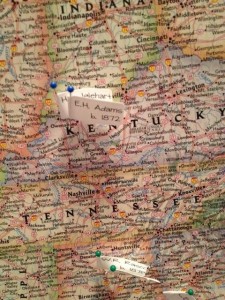 I wrote a couple of weeks ago that I was purchasing a large map of the United States so that I could mark where my ancestors lived and get a better sense of my geographic origins. I figure it will also be helpful in planning research trips. Mapping my genealogy has proven to be great fun.
I wrote a couple of weeks ago that I was purchasing a large map of the United States so that I could mark where my ancestors lived and get a better sense of my geographic origins. I figure it will also be helpful in planning research trips. Mapping my genealogy has proven to be great fun.
I’ve been giving a lot of thought as to how to mark the map. I didn’t know if I should include just birth places, just death places or both. Should I include marriage places? How would indicate who a pin represented? Should I color code? If so, how many colors? What kind of pins?
After a week or two of thought, yesterday I settled on this strategy:
- I’m using one-inch-long pins with colored heads
- I’m color-coding the pins by branch of family (to match the way I’ve color-coded my paper files, one color per grandparent and his/her ancestors)
- I’m marking both birth and death places
- Each pin is the appropriate color and has a flag on it indicating the ancestor and birth or death date
I’m using Avery return address labels (#5167) for the flags. That seems to be a good size to capture the information legibly. On the first line, I put first and middle initials and last name. On the second line is the birth or death date. The info is right justified. Once I’ve printed out the label, I fold it in half around the pin and it sticks to itself.
I’ve decided to pin systematically and have started with my grandparents and great grandparents. Once I finish pinning all the ancestors for whom I have verified information and the backlog is complete, I’m anticipating the thrill of adding a pin when I establish the birth and death date of an ancestor.
I’m kind of shocked at how fun and rewarding this is. Time is flying as I work on it. A side benefit is that it’s making me realize the ancestors for whom I’m missing birth cities or counties (my paternal grandparents, for instance!).
This is just one of the many ways that family history research is such a fun and satisfying hobby for me.
